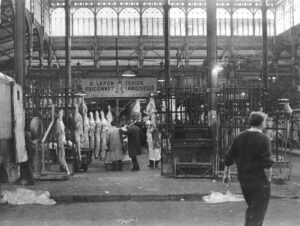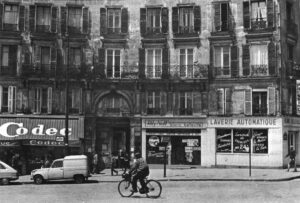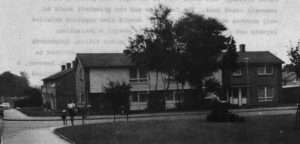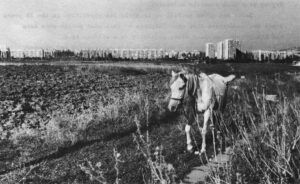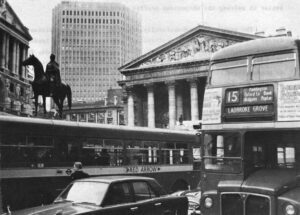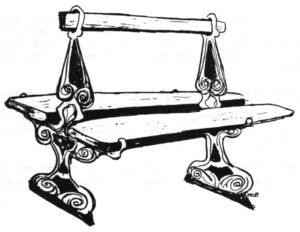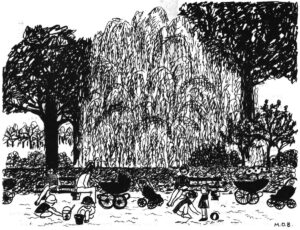We seem to lack not only answers to some most pressing questions, but also useful ways of asking them
Paris, October 11, 1969
“And just what is it you do, Mr. Barnes?”
The question wants a snappy answer like “European sales, Acme Can.” Somehow, “I try to understand how different cities cope with change” is an answer that gets lost in the rattle of ice cubes.
The trade of studying cities lacks a name. It also lacks a definition. But there are quite a few of us who practice it, in various ways. The city editor, the city planner, the mayor, Lewis Mumford and Jane Jacobs each “know the city,” and trade on their ability to understand how it works. They don’t agree. Not only is there discord over which measures will solve what troubles; they understand quite different things by the word city itself. One definition will be geographical, another social, a third political. All will be right. All will omit aspects that obviously cannot be ignored.
Each of us works out something that will serve, however, some standard by which to say of the daily happenings “this has meaning, this has none.” Often the standard is casual, used because it was used some years or decades ago. A man biting a dog is not really a very good story at all.
“Is it odd?” remains a standard for judging city news. Often what we know least is the ordinary, that which is not odd. How does the city actually work every day?
Being unsure of what is going on, judgments on whether a change will be an improvement are pretty chancy. Lacking a coherent picture of how the present equilibrium is formed, a new force, however well meant, can have strange results indeed.
What do you do to prevent the next riot when you lack certain knowledge of what caused the last one? What you do, of course, is hire more police and hope the basic trouble goes away. After a while the police themselves are a basic trouble.
There is disagreement on the simplest judgments about how a city works. It is difficult to say anything about a city, or cities in general, without risking an argument. Colleagues will vary sharply on how to handle a given situation.
Sure, different people always see things a little differently. Nothing could be more usual than the differences among a dozen congressmen. But they would all be pretty clear something needed to be done about the man standing in the House gallery pointing a rifle.
A few things are obvious.
Not so obvious in the situation where the man is standing on a big city sidewalk holding a knife.
The editor must ask who is the man, which sidewalk? Is he brandishing the knife or carrying it home from the store? Was there really a knife at all, or was that what the police said just after they shot him?
The mayor must choose between sending too many police to deal with the man, and having a possible riot on his hands, or sending too few police and having a possible riot. He will make enemies either way.
The city planner, too, must choose about the knife wielder. Is it better to tear down the tenement that brings him to the city, or repair it? Is it possible to do either within a lifetime? Another man in any of these jobs may well react the opposite way. Not only will the judgments of colleagues vary. The decision of the mayor will make a difference to how the editor reacts, and vice versa. Yet they may in fact be trying to hide their judgments from one another. Even when there is good will, there is only the most casual intercourse among the different men directly concerned with how events affect the city’s future. There is little attempt at synthesis or overview.
When I began this fellowship year, I thought to myself:
“It’s because I’ve been too busy, and too lazy, that I don’t understand what has been going on in my city and other cities.
“Finally I’ll be able to read the literature and get some answers.”
Answers abound. They are too often fragmentary and contentious. There is a great deal of hack writing, with people repeating the ideas of others without reference to reality. There is too little that feels solidly right. The basic body of material that everybody concerned with cities must have read does not exist; certainly it is not identified and used as such.
The technicians are on the most certain ground in writing about cities The engineers can say flat out this is how you build this kind of street. This kind of tree will grow here. The planner knows a suburb must have this many stores for this many people.
The statisticians, too, are on good ground. What is written in the “Statistical Abstract” and the UN’s “Compendium of Social Statistics” is likely to be true. Relative size of cities, their rates of growth, housing need and availability – these and hundreds of other specifically measured aspects of cities are particularly useful in determining whether another line of argument is sensible or not.
Statisticians also tell you how much they know and how they know it, a pleasure in a field where an idea often becomes a world scheme.
Newspapers are in this same range. As far as they go, they are often right. “This happened yesterday” is very useful in trying to understand what is going on in a city.
Newspapers also try sometimes to put the bits and pieces together into an overall picture. Suffering, like everybody else, from the lack of an agreed core of judgments about how cities work, the results vary over a period of time from the naive to the super-sophisticated.
Newspapers are, unfortunately, unreliable about cities. There is no assurance at all that picking up the paper in a strange city you will learn anything more about the city than that it has a bad paper.
Newspaper judgments about how cities work as a whole are implied, never explicit. You have to know a paper pretty well to know whether it is in the Chamber of Commerce’s pocket.
City staffs are eager and young. They commit errors. This youth is also their strength. A person who has the energy to go out and see what is happening and then come back to tell you about it can be forgiven many faults.
City planners are best at solving specific problems. They really can design streets to keep cars from running over so many little children. They can put enough stores in the right place. They can put the park where there are a few trees left.
A city planner can avoid stupidities. A well planned development will not find itself without sewers, or water, or transportation, as cities seem still to be forever doing.
This kind of information and training is widely available to the specialists. They take an academic degree in it. It is seldom because the planner didn’t know any better that a new apartment complex is built without a sewer. It is usually because some other, more powerful element in the urban equilibrium overrode, or didn’t hear.
One reason, perhaps, that planners are not given full control over mechanical aspects they can deal with best is that they use the same tone of voice to describe much more controversial total-city views.
People in power, disagreeing with Planners’ grand views, are reluctant to give them too strong a say in anything. It has been in the overview of cities that planners have been most vulnerable. For example:
For decades it was an article of planning faith that residence and industry should be separated. The new fashionable idea is the walk to work from an adjacent residence.
For decades planners, as realists, urged that cities make it easier for cars to move around. There now seems at least room for the view that cars should be kept out of cities entirely.
I find that the “Wedges and Corridors” master plan for the city of Washington is famous throughout Europe. It is cited as an example of how far we have progressed. In Washington it seemed much less clear the plan was anything more than handsomely printed paper; visions to be ignored when it came to real matters like money and land development.
Planners can provide information, they can refine the terms of discussion, they can carry out policy into detailed plans. What they do least well is provide this general understanding of how a city works that I’ve been talking about. We continue to demand of planners that they provide just such overviews and then to disregard them.
Everyone who has had anything to do with planners is familiar with the well-thought-out $400,000 plan that is ignored. It generally means planners were trying to dictate how a city should work, in ways the leaders and citizens would not follow. We are not willing to accept dictatorship of the technocracy.
There are people whose main business is telling us how cities run and ought to run. Theirs is the overall scheme we lack. Ours is the widespread acceptance they lack.
The range, and I make no claim to have come across everything or to have read everything I’ve come across, is from Ebeneezer Howard and Max Weber to Lewis Mumford and Jane Jacobs. Anybody who says any one of them is wrong, or right, is likely to get into a nasty fight.
The real thrust, it seems to me, of this kind of book is to tell us how our cities, when perfected, should run. They argue from the past and present forward to the future by example, not by survey. At best they are insightful, but their generalizations are faulted.
Each that I have tried to master is still in the stage where it is all too easy to say “yes, but….” “Yes, but what does Greenwich Village have to do with Hartford or San Jose, Mrs. Jacobs?” “Yes, but what does the English new town have to do with Bedford Stuyvesant, Mr. Mumford?”
There are excellent studies of particular aspects of cities: Charles Abrams on housing, Herbert Gans or Ronald Frankenberg on the definition of community, Peter Laslett on social history, Baron Haussmann himself on the rebuilding of Paris.
But they lack bibliographers. It is a matter of following dozens of leads in a library, buying a book on a gamble. All of which is fine for me this year, and for academic scholars.
The mayor, the editor and the city planner don’t have that time. I think it unlikely most even know about the literature on cities, that it might both aid and interest them.
Perhaps a city is simply too diverse to be understood all at once. It is not a blend of two or a dozen elements, with two or a dozen goals, like most institutions. It is tens of thousands.
What happens to a city matters too much. It cuts too deeply into the lives of its citizens. A man’s public image, and his idea of himself as well, are in good part determined by the street and house where he lives. Whether a man drives his nice shiny car to work has as much to do with ego as convenience.
To be held up, to look down at a gun held by some fool who may not know what a mistake it would be to use it, is not an experience
To be the son of a no-account, born to a slum, and expected to be a no-account yourself, is not the kind of thing a boy shrugs off.
These are what we call by the numbing names of city problems – property values, transportation, law enforcement, welfare.
The person who has just been held up will have a hard time coming up with a balanced viewpoint on law and order. Cities are like that for everybody. We each see and emphasize our own little piece, not the shifting equilibrium that actually is how a city works.
Crime rates may be a useful example of the predicament I am trying to describe.
Interest in crime is absolutely unquenchable. A woman got raped in the next block, there have been two break-ins in the building in the last 10 days – whatever it is, we are all being increasingly sensitized to crime. Every city dweller has an acquaintance who has recently been the victim of a crime.
Crime statistics climb regularly. A responsible headline writer will come up with “Crime Up 27 Per Cent for July.” at least it isn’t “Crime Wave Belts Gotham.” But it isn’t quite right, either. The figures were for the number of crimes of a certain type, that people decided to tell the police about, that the police decided to record.
This argument sounds like quibbling. Any fool knows crime is up.
It seems less like quibbling when you realize fewer than half of serious crimes are reported, and there have been many big cities that very recently did not record crime committed against Negroes. Crime figures have frequently been arbitrarily set at a level where the chief thought they would help his budget request.
Crime is up, all right, but it takes each city several years to begin to get figures that mean something. After a while you can begin to know not only that crime is up, but where and how.
By this time an impatient electorate, perfectly understandably, has demanded and gotten more police. People are not willing to wait for the song and dance. “There must be a simple answer. If you tell me there is not, you are probably hiding it from me for your own devious reasons.”
So after five years, or it may be approaching ten by now, officials and the press begin to start examining race and class as they bear on city crime. Narcotics addiction is studied as well as deplored. Maybe, it seems, somebody will come up with an approach with some hope of success. We may know enough about criminality in the city to begin to act effectively. Whether we will also solve the problems that have been created by long-standing mistrust and fear is another question.
But then you watch the same cycle begin in a different political subdivision of the same city, a lower class suburb perhaps. You watch another city just begin to learn to count its crimes usefully. There is a feeling of deja vu. Those crime wave headlines must be ten years old. They are not. In cities we have a way, all unknowing, of repeating each others’ errors.
Lacking a tidy curriculum to follow, a teacher to accept, what I do is try to understand why cities deal with their serious problems one way and not another.
“You say, Mr. Barnes, that you came to Paris and quit being an editor in order to learn about being an editor in Washington? Hmmm.”
Received in New York on October 14, 1969.
©1969 Andrew Earl Barnes
Andrew Earl Barnes, Assistant City Editor of The Washington Post, is on leave for a year to study European cities as an Alicia Patterson Fund Fellow.

